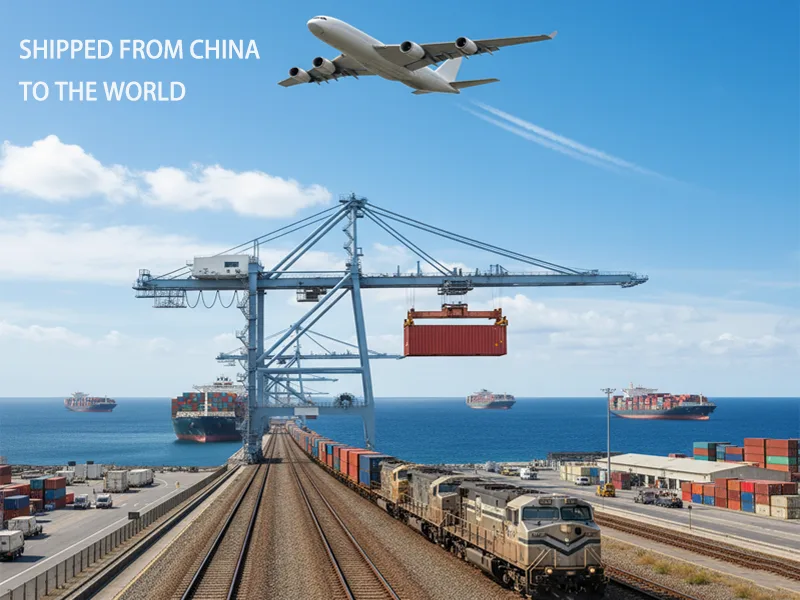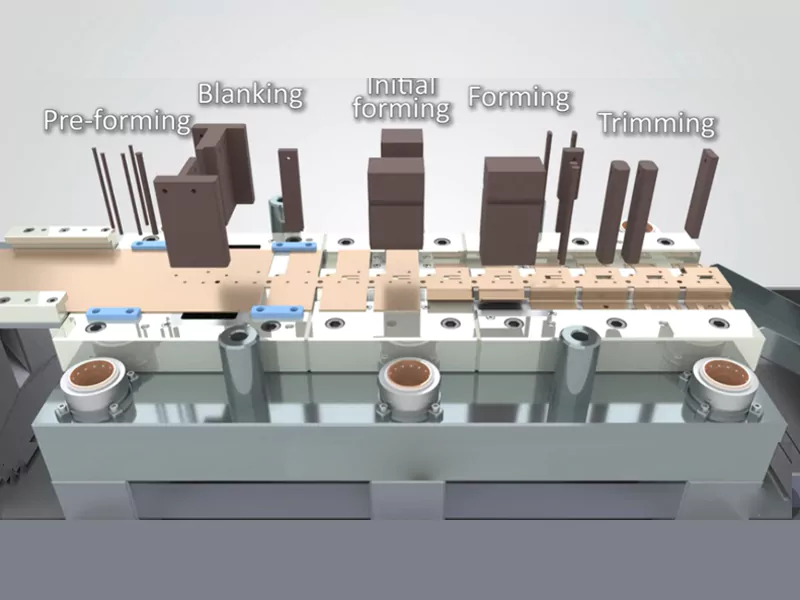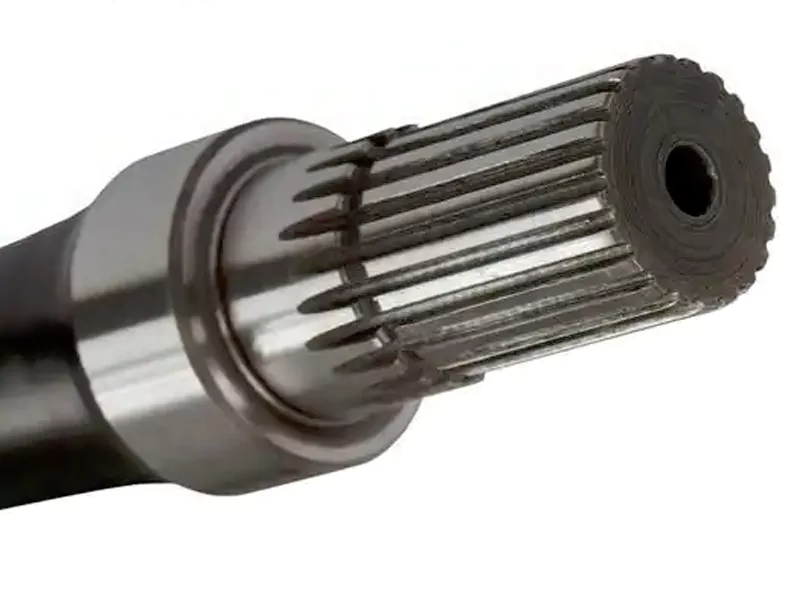When you look at ways for shipping cost from China to the world, sea freight is usually the cheapest option. This is particularly true for large shipments. The table below shows average prices for air freight, ocean freight, and rail. Recently, rail prices have decreased.
| Shipping Route | Air Freight (Per kg) | Ocean Freight (FCL/LCL) |
|---|---|---|
| China to United States | $3.8-4.2 | FCL: $2,522 (FEU, LA), LCL: $45-55 (per CBM) |
| China to Germany | $4.5-5.0 | FCL: $2,385 (FEU, Rotterdam), LCL: $60-70 (per CBM) |
| China to Saudi Arabia | $4.0-4.5 | FCL: $1,800-2,100 (FEU, Jeddah), LCL: $50-60 (per CBM) |
| China to United Arab Emirates | $3.6-4.1 | FCL: $1,600-1,900 (FEU, Dubai), LCL: $45-55 (per CBM) |
| China to Kenya | $5.0-5.5 | FCL: $2,200-2,500 (FEU, Mombasa), LCL: $65-75 (per CBM) |
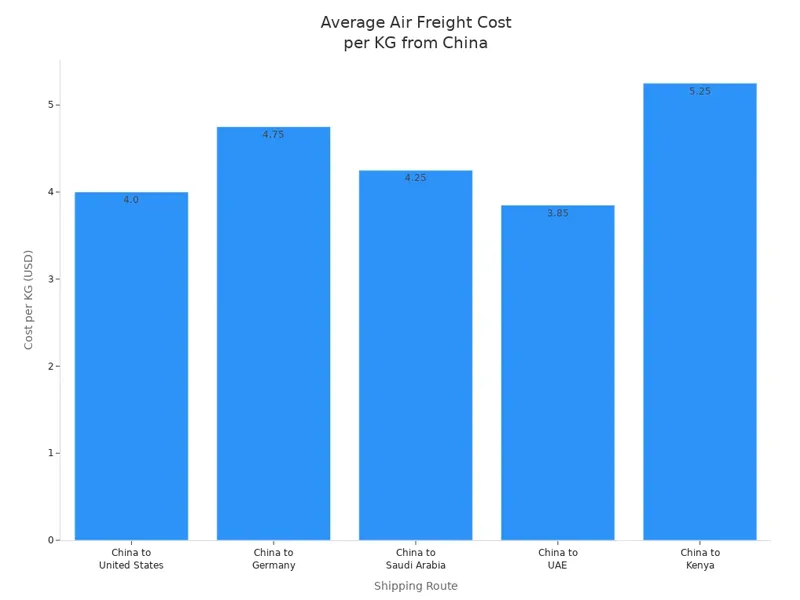
You need to consider shipment size, how quickly you need it, where it is going, and what you are shipping. Ocean freight remains a great deal for shipping from China to the world. Air freight and rail are better suited for fast delivery or special items.
Key Takeaways
- Sea freight is the cheapest way for big shipments. It often costs less than $0.50 for each kg.
- Air freight is the fastest way to ship things. It can deliver goods in 1 to 3 days. But air freight costs a lot more money.
- Rail freight is good for both price and speed. It works well for medium shipments going to Europe.
- Think about how big your shipment is. Also, think about how fast you need it and where it is going. This helps you pick the best shipping method for cost and time.
- If your items are urgent or worth a lot, air freight is safer. It has better tracking and keeps your delivery safe and on time.
- Sea freight is good for cargo that is not urgent. It saves money, especially when you ship a lot at once.
- Always look at the newest shipping prices and market news. Prices can change every week because of demand and fuel costs.
- Talk to logistics experts if you need help. They can help you solve shipping problems and choose the best way for you.
Table of Contents
Cost Comparison Overview
Shipping from China to the World
If you want to ship from China, you should know the main places goods go. Many companies send things from China to North America, Europe, Southeast Asia, the Middle East, and Africa. These areas get the most shipments from China. China sends goods to almost every big market.
- North America (United States, Canada)
- Europe (Germany, UK, France, Netherlands)
- Southeast Asia (Vietnam, Thailand, Malaysia)
- Middle East (UAE, Saudi Arabia)
- Africa (Kenya, Nigeria, South Africa)
Each place has different shipping costs and times from China. The route and method you pick depends on your goods, how fast you need them, and your budget.
Cost per KG: Air, Sea, Rail
You should look at the cost per kilogram for air, sea, and rail when shipping from China. Air freight is the fastest, but it costs the most. Sea freight is the cheapest for big shipments, especially with full or less than container loads. Rail is in the middle for speed and price, but it mostly goes between China and Europe or Central Asia.
Here is a simple cost chart for air freight from China to main areas:
| Destination Region | Average Air Freight Rate (per kg) |
|---|---|
| North America | $5.50 – $8.50 |
| Europe | $5.00 – $7.00 |
| Southeast Asia | $3.50 – $5.00 |
Rail freight from China to Europe and Central Asia usually costs $0.6 to $1 per kg. Sea freight prices change by container size, but the cost per kg is much lower for big shipments. Sea freight can be less than $0.50 per kg for full containers.
Tip: Shipping costs from China depend on container size, shipping method, and where you send it. Prices change every week because of the market, fuel, and busy seasons.
Transit Times
How long shipping takes is important when you pick a method from China. Air freight is the fastest way to get your goods. Sea freight takes the longest time. Rail is in the middle for trips between China and Europe.
| Region | Sea Freight (Days) | Air Freight (Days) | Rail Freight (Days) |
|---|---|---|---|
| North America (West) | 20-25 | 8-10 | N/A |
| North America (East) | 30-35 | 3-5 | N/A |
| Western Europe | 25-30 | 5-10 | 14-18 |
| Northern Europe | 30-35 | 5-10 | N/A |
| Southern Europe | 27-32 | N/A | N/A |
| Asia-Pacific (Australia) | 15-20 | 5-7 | N/A |
| Asia-Pacific (Japan) | 3-5 | 1-2 | N/A |
| Asia-Pacific (South Korea) | 4-6 | 1-3 | N/A |
| Southeast Asia | 9-12 | 2-5 | N/A |
| India | 15-20 | N/A | N/A |
| Eastern Africa | 30-35 | 5-8 | N/A |
| Western Africa | 40-45 | 6-10 | N/A |
| South America (East) | 30-35 | 7-12 | N/A |
| South America (West) | 45-50 | 8-12 | N/A |
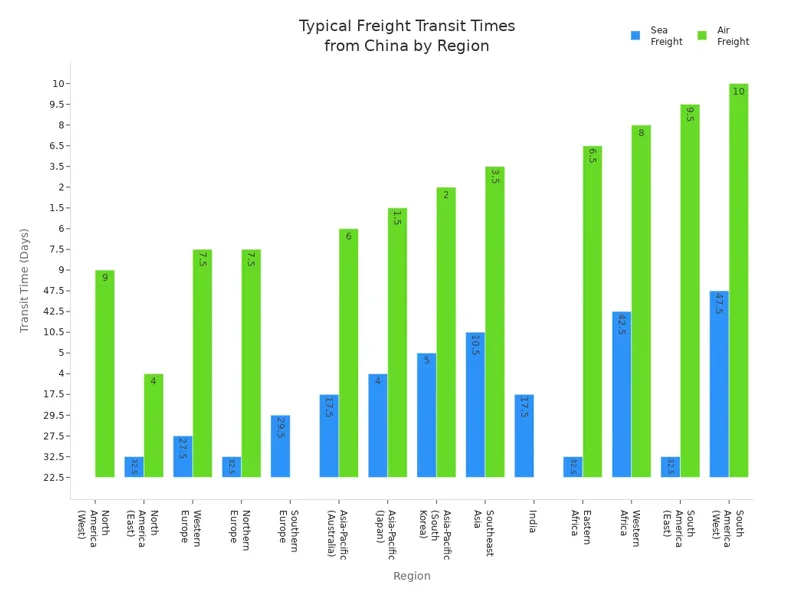
Shipping costs from China have changed a lot this year. High demand and problems in the Red Sea made prices go up. These higher costs will likely stay through the summer. Container prices also change with world demand, busy ports, and new rules. You should check prices often because they can change every week.
Note: When you compare shipping from China, always look at both cost and time. The best way depends on your shipment size, how fast you need it, and where it is going.
Air Freight: China Rates
Shipping Costs from China
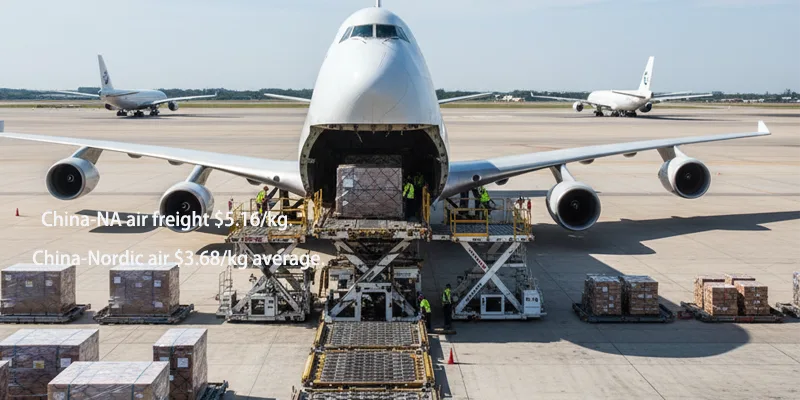
When you choose air freight, you get the fastest delivery from China to the world. The shipping cost from China to USA depends on the route and the weight of your cargo. For example, the average rate for air freight from China to North America is $5.16 per kilogram. If you ship to Northern Europe, the rate drops to $3.68 per kilogram. You can see the main rates in the table below:
| Route | Rate (per KG) |
|---|---|
| China to N. America | $5.16 |
| China to N. Europe | $3.68 |
The shipping cost from China to USA by air changes with the season and demand. You may find lower rates if you use consolidated shipments or flexible schedules. Air freight works best for shipments above 20kg. For these, you often pay between $3 and $10 per pound. Delivery usually takes 7 to 14 days. If you want to save on the shipping cost from China to USA, you can try these methods:
- Combine smaller shipments with others to share costs.
- Use less urgent flights for lower rates.
- Ship in bulk to get better deals.
- Pick flights with stopovers to reduce the shipping cost from China to USA.
When to Choose Air Freight
You should pick air freight when you need speed and reliability. This method suits certain situations better than others.
Urgent Shipments
If you need your goods fast, air freight is the best choice. Air delivery from China to the USA can take as little as 3 to 10 days. This speed helps you keep your supply chain moving. When you face tight deadlines, air gives you peace of mind.
High-Value Goods
Air freight also works well for high-value or sensitive items. Air transport offers better security and tracking. You can trust that your goods will arrive safely and on time. If you ship electronics, fashion, or medical products, air is often the safest option.
Pros and Cons
You need to weigh the pros and cons before you choose air freight for your shipment from China. The table below shows the main points:
| Advantages of Air Freight | Disadvantages of Air Freight |
|---|---|
| Speed: Fastest delivery method, taking 18–21 days from China compared to at least 70 days by sea. | Cost: Air freight is significantly more expensive, costing 12-16 times more than sea freight. |
| Reliability: Stable conditions for cargo, reducing spoilage risk. | Risk of Damage: Packages can be more vulnerable to damage due to handling and pressure changes. |
| Safety: Statistically the safest mode of transport. | Environmental Impact: Larger carbon footprint compared to sea freight. |
| Accessibility: Reaches locations that may not be accessible by other transport modes. | N/A |
| Cargo Control: Better tracking and quicker loading/unloading times. | N/A |
| Direct Routes: Faster delivery without intermediate stops. | N/A |
Note: Air freight gives you unmatched speed and control, but you pay a higher shipping cost from China to USA. You should use air when time and safety matter most.
Sea Freight: Cheapest Option
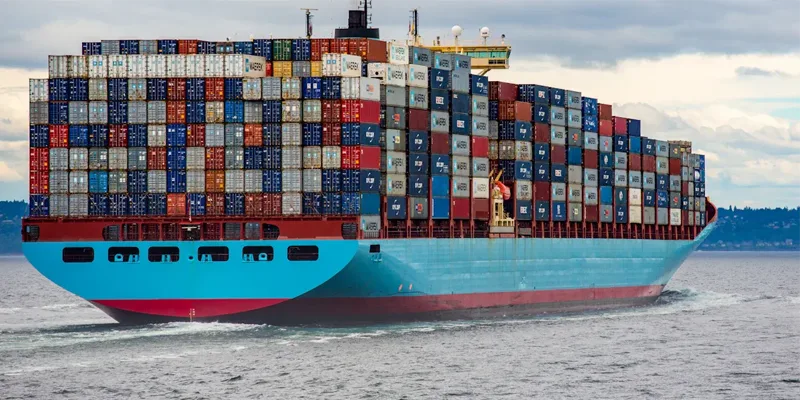
Cost per KG
Sea freight gives you the lowest cost per kilogram for most shipments from China. When you compare shipping methods, sea stands out for large and heavy cargo. If your shipment weighs more than 500 kg, sea freight becomes much cheaper than air. You can choose between FCL (Full Container Load) and LCL (Less than Container Load). FCL lets you ship a whole container for a flat rate, no matter how full it is. LCL means you share space with others, which can save money for smaller loads but may take longer because of extra handling.
Tip: Sea freight works best for bulk shipments. The more you ship, the lower your cost per kg.
Shipping Cost from China to UK
You need to know the shipping cost from China to the UK before you plan your shipment. Sea freight offers the most affordable rates for this route. For FCL, you pay a flat fee for the whole container. This method is best if you have enough goods to fill a container. For LCL, you pay based on the volume or weight of your cargo. This option suits smaller shipments that do not fill a container.
Here are some key points about container shipping rates from China to uk:
- FCL rates give you a fixed price for the entire container, making budgeting easier.
- LCL rates depend on how much space your goods take up in the container.
- Sea freight rates from China to the UK can change each week due to demand, fuel prices, and global events.
- The shipping cost from China to the UK by sea is usually much lower than air, especially for heavy or bulky items.
- You should always check the latest container shipping rates from China to the UK before booking.
- Sea routes from China to the UK often take 25 to 35 days, so plan for longer transit times.
- The shipping cost from China to the UK drops as your shipment size increases, making sea freight ideal for large orders.
- Many importers use sea freight to keep the shipping cost from China to the UK as low as possible.
When to Choose Sea Freight
Sea freight fits many shipping needs. You should pick this method when you want to save money and can wait for delivery. Here are the best times to use sea freight:
Large Volume
If you need to move a lot of goods, sea freight is your best choice. You can ship furniture, appliances, or even vehicles. Full containers give you the best shipping cost from China to the UK. Sea shipping handles big and heavy items with ease.
Non-Urgent Cargo
Sea freight works well when you do not need your goods right away. If you have a flexible timeline, you can wait a few weeks for delivery. Many people use sea freight for household moves, business stock, or items that do not spoil. You get a low shipping cost from China to the UK and can plan your inventory around the longer transit time.
- Sea freight is ideal for:
- Comprehensive household moves, including furniture and appliances.
- Shipping vehicles like cars or motorcycles.
- Any shipment where waiting a few weeks is not a problem.
Note: Sea freight gives you the lowest shipping cost from china to uk, but you need to plan for longer delivery times. Always check the latest container shipping rates from china to uk before you ship.
Pros and Cons
When you consider shipping from China, sea freight stands out as the most cost-effective choice for many businesses. You get several benefits when you choose this method, but you also face some challenges. Understanding both sides helps you make the best decision for your shipment.
Here is a clear table that shows the main pros and cons of sea freight:
| Pros of Sea Freight | Cons of Sea Freight |
|---|---|
| Better for large or abnormally shaped goods | Slower shipping times compared to air freight |
| More capacity for shipping high-volume orders | Potential for delays due to weather or port issues |
| Less expensive than air freight | Limited tracking options during transit |
| More environmentally friendly with lower carbon footprint | Requires more time for customs clearance |
You can ship large or oddly shaped items with sea freight. This method gives you more space and flexibility than other options. If you need to move high-volume orders, sea freight handles them with ease. You also pay less per kilogram, which helps you save money on big shipments. Many companies choose sea freight because it is more environmentally friendly. Ships use less fuel per ton than planes, so you lower your carbon footprint.
However, you need to plan for longer delivery times. Sea freight moves slower than air, so your goods may take weeks to arrive. Weather or port problems can cause delays. You may not get real-time tracking for your cargo, which makes it harder to know where your shipment is at all times. Customs clearance for sea shipments often takes longer, so you should allow extra time for paperwork.
Tip: If you want to save money and ship large loads, sea freight is your best option. Make sure you plan for extra time and check for possible delays.
Sea freight works well for many types of cargo, but you need to weigh the pros and cons before you decide. If speed is not your top priority, and you want to keep costs low, sea freight gives you the best value.
Rail Freight: Middle Ground
Cost Comparison
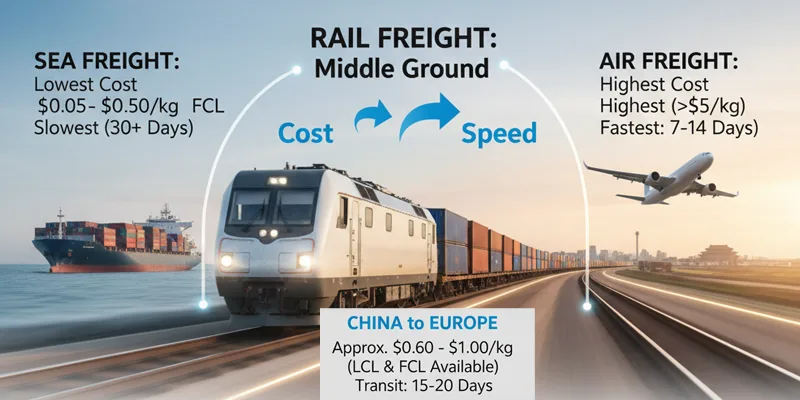
You may find that rail freight offers a unique balance between cost and speed when shipping from China to Europe. While sea freight remains the cheapest option for large shipments, rail freight provides a middle ground. The cost per kilogram for rail freight usually falls between air and sea freight. If you need to move goods faster than sea freight but want to avoid the high price of air, rail freight can help you save money and time.
Rail freight rates from China to Europe often range from $0.6 to $1 per kilogram. This rate is higher than sea freight, which can be less than $0.50 per kilogram for full containers, but much lower than air freight, which often exceeds $5 per kilogram. You can use rail freight for both full container loads and less than container loads (LCL). LCL lets you share space with other shippers, which keeps costs competitive and gives you flexibility.
Tip: Rail freight works best for medium-sized shipments that need to arrive faster than sea freight allows but do not require the speed of air.
China-Europe Transit Times
Rail freight from China to Europe offers much faster transit times than sea freight. Most rail routes take between 12 and 20 days, depending on the destination city. This speed makes rail freight a strong choice for businesses that want to keep inventory moving without paying for air freight.
Here is a table showing average rail freight transit times from China to major European cities:
| Route | Average Transit Time |
|---|---|
| Chengdu to Duisburg | 12-14 days |
| Xi’an to Hamburg | 14-16 days |
| Wuhan to London | 15-18 days |
| Yiwu to Madrid | 16-20 days |
| Nanchang to Warsaw | 14-16 days |
You can also see how rail freight compares across more routes:
| Route | Transit Time |
|---|---|
| China → Lyon (France) | 14–17 days |
| China → Brussels | 12–14 days |
| China → London | 18–20 days |
| China → Hamburg | ~14 days |
| China → Warsaw | ~12 days |
| China → Moscow | ~12 days |
| China → Duisburg | 15–18 days |
| China → Madrid | 20–22 days |
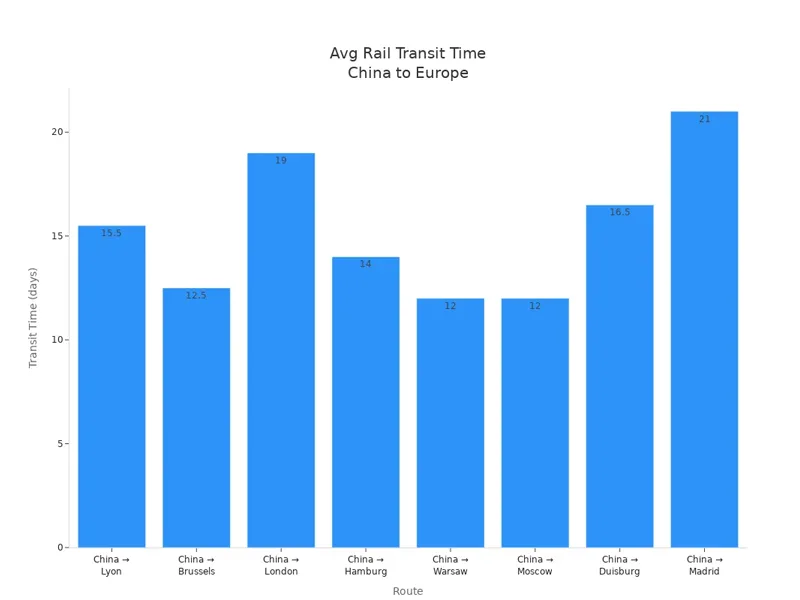
Note: Rail freight gives you a reliable schedule, which helps you plan your supply chain better than sea freight.
When to Choose Rail Freight
You should consider rail freight when you want a balance between cost and speed. This method works well for certain types of shipments and business needs.
Balance of Cost and Speed
Rail freight stands out if you need your goods delivered faster than sea freight but do not want to pay for air. You can expect your shipment to arrive in about two to three weeks. This timeline is much shorter than the four to six weeks often needed for sea freight from China to Europe. Rail freight helps you keep your inventory moving and reduces the risk of stockouts.
Suitable Cargo Types
Rail freight suits a wide range of goods. You can use it for moderately urgent shipments, medium-sized loads, and products like automobiles, parts, and appliances. The table below shows which shipments work best for rail freight:
| Shipment Type | Suitability for Rail Freight | Timeframe | Cost-Effectiveness |
|---|---|---|---|
| Moderately Urgent Goods | Ideal | 18-20 days | Cost-effective |
| Medium-Sized Shipments | Ideal | 18-20 days | Cost-effective |
| Automobiles, Parts, Appliances | Ideal | 18-20 days | Cost-effective |
You can also use LCL (Less than Container Load) service. This option lets you share a container with other shippers, which keeps costs low and gives you the benefits of rail freight.
Tip: Rail freight is a smart choice for businesses that want to save money compared to air and need faster delivery than sea freight can provide.
Pros and Cons
When you think about rail freight from China, you should look at both good and bad sides. Rail freight is fast and saves money, but it does not work for every shipment or place.
Here is a simple table with the main good and bad points of rail freight:
| Advantages | Disadvantages |
|---|---|
| Speed of delivery | Limitations in accessibility |
| Cost-effectiveness | Handling complexities |
| Environmental benefits | Potential costs for short-distance journeys |
| Reliability |
Rail freight gets your goods to Europe faster than ships. Trains take about 12 to 18 days. Ships can take 30 to 40 days. This speed helps you keep your products in stock. Rail freight has steady schedules. Trains do not get delayed by weather as much. You can plan your shipments with less worry.
Rail freight costs less than air transport. You save money and still get quick delivery. This helps your business get paid faster. Rail uses less fuel than trucks, ships, or planes. This makes it better for the environment. You help lower pollution and support green shipping.
Trains are safer than other ways to ship. They have fewer accidents. Your goods are more likely to arrive safely.
But rail freight has some problems. Not every place has train tracks nearby. You may need trucks to move goods to and from the train station. This can make shipping harder. Rail freight can cost more for short trips. It works best for long routes.
Small shipments may not save you much money with rail. If you ship just a few items, you might pay more than you want. Rail is not as fast as air. If you need your goods very quickly, you should pick another way.
Tip: Use rail freight for medium or big shipments that need both speed and good prices. Check if your destination has train service before you choose rail.
Think about these good and bad points before you decide. Rail freight is best when you want fast, steady, and cheap shipping to places with good train service.
Key Factors Affecting Choice
When you decide how to ship goods from china, you need to look beyond just the price. Several important factors can help you choose the best shipping method for your needs.
Speed and Reliability
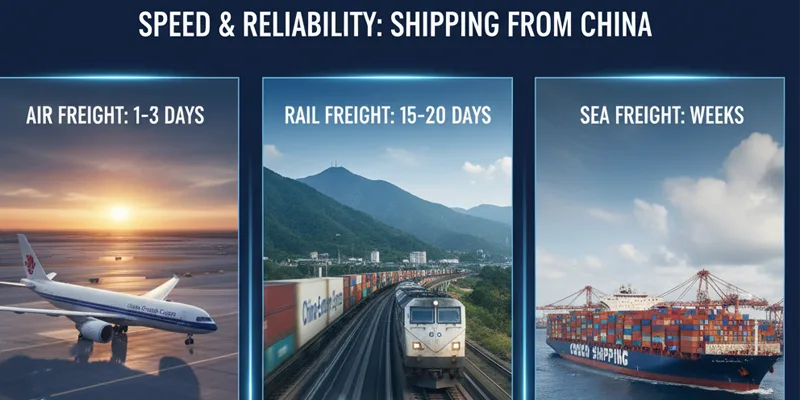
Speed and reliability matter a lot when you ship products from china. Each shipping method offers different benefits:
- Air Freight: You get the fastest delivery. Air freight can move goods from china to most destinations in just 1–3 days. This method works best for urgent shipments and high-value items. You also get strong security and tracking.
- Rail Freight: Rail offers a balance between speed and cost. Trains from china to Europe usually take 15–20 days. Rail is more reliable than sea freight and less likely to face weather delays.
- Sea Freight: Sea shipping is the slowest. It often takes several weeks for goods to travel from china to other continents. Sea freight works best for bulk shipments, but you may face delays at ports or from bad weather.
Tip: If you need your goods quickly, choose air freight. For a balance of speed and cost, rail is a smart option. Sea freight is best when time is not a concern.
Cargo Type
The type of cargo you ship from China affects your choice of shipping method. Different goods have special needs:
- Lightweight and valuable items, like electronics or jewelry, travel best by air. Air freight protects fragile goods and gets them to you fast.
- Heavy or bulky goods, such as machinery or furniture, fit well with sea or rail freight. Sea freight is the most cost-effective for large loads over long distances.
- Rail freight handles heavy and bulky items well, especially for routes between China and Europe.
You should also think about how easily your goods can get damaged. Some items need careful handling. Inspection and better packing can help reduce damage and lower costs.
Destination
Your destination plays a big role in your shipping decision. Not every country has the same infrastructure or rules:
- Some countries have strong rail links with China, making rail freight a good choice.
- Others rely on major ports, so sea freight is easier and cheaper.
- Air freight reaches almost any city with an airport, giving you flexibility.
You must also follow local customs and import rules. Accurate paperwork helps you avoid delays. Each country sets its own product standards, which can affect your shipping method. Always check the latest regulations before you ship from China.
Note: Good planning and understanding of your destination’s rules will help you avoid costly mistakes.
Recommendations
Shipment Type
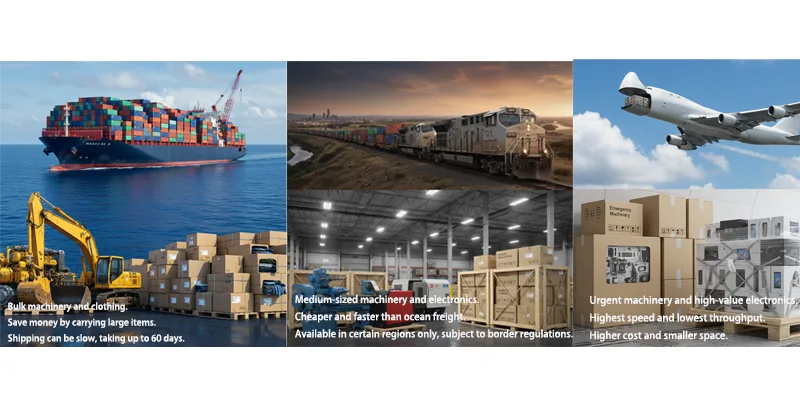
Picking the right shipping method depends on what you ship from China. Every cargo type has a method that works best. Match your goods to the shipping method that fits their needs. The table below shows which shipping method is good for electronics, clothes, and machinery:
| Shipping Method | Best For | Pros | Cons |
|---|---|---|---|
| Sea Freight | Bulk machinery, apparel | Saves money, carries big items | Slow delivery, up to 60 days |
| Air Freight | Urgent machinery, high-value electronics | Fastest, less handling | Costs more, not much space |
| Rail Freight | Mid-weight machinery, electronics | Cheaper, quicker than sea | Only some places, border rules |
If you ship lots of electronics or machinery, sea freight from China is the best deal. If you need to move expensive electronics fast, pick air freight. Rail freight is good for medium shipments, especially between China and Europe.
Tip: Check if your cargo needs special care or quick delivery. This helps you avoid waiting and extra fees.
Urgency vs. Budget
You need to decide how fast you want your goods from China and how much you want to pay. Each shipping method gives you a different mix of speed and price. The table below helps you match your needs:
| Shipping Method | Ideal Use Case | Cost Implication |
|---|---|---|
| Sea Freight | Big loads, heavy items, not urgent | Cheap but slow |
| Air Freight | Small, pricey, or urgent goods | Costs more |
| Rail Freight | Good balance for speed and price | Medium cost |
| Courier Services | Small packages or urgent shipments | Costs more for speed |
If you need your shipment from China quickly, use air freight or courier services, but you will pay more. For big or non-urgent shipments, sea freight saves money. Rail freight is a middle choice for both speed and price, especially for China-Europe trips.
When you compare choices, look at more than just the main shipping price. You should also think about:
- Freight charges: Ask for prices from different carriers.
- Extra fees: Customs, taxes, terminal fees, and storage.
- Packing costs: Some items need stronger packing.
Note: Always check how long shipping takes and watch for delays. Pick companies that deliver on time.
Negotiating Rates
You can save money on shipping from China by using smart ways to get better prices. Here are some steps you can try:
- Ask for quotes from different freight forwarders. This lets you compare prices and services.
- Bargain based on how much you ship. If you ship a lot, ask for lower rates.
- Put small shipments together to make bigger ones. This can help you get bulk discounts.
- Make good relationships with your freight partners. Good partners may give you better deals and cheaper routes.
Tip: If you are not sure about the best way to ship from China, talk to a logistics expert or freight forwarder. They can help you pick the best choice for your needs and budget.
Shipping from China offers three main options, each with unique benefits.
| Carrier Type | Typical Cost per KG | Ideal Cargo Type |
|---|---|---|
| Sea Freight | $0.10 – $0.30 | Bulk cargo, pallets, high-volume goods |
| Rail Freight | $0.60 – $1.00 | Mid-sized shipments, faster than sea |
| Air Freight | $3.50 – $8.00 | Urgent, lightweight, or high-value goods |
You should match your shipping method to your needs.
| Factor | Description |
|---|---|
| Shipping Time | How quickly you need the goods |
| Shipping Cost | Your budget and profit margins |
| Types of Goods | Restrictions based on the type of goods |
| Shipping Capacity | Dimensions, weight, and volume of your products |
To optimize your process:
- Prepare all customs documents.
- Select the right shipping method for your needs.
- Partner with reliable freight forwarders.
- Understand Incoterms and plan for lead times.
Consulting logistics experts helps you solve complex shipping challenges and keeps your supply chain efficient.
FAQ
Sea freight is the cheapest for big shipments. It works best for heavy or large items. You pay less per kilogram than air or rail.
Think about your shipment size, speed, and budget. Air is good for urgent or valuable goods. Sea is best for big, non-urgent cargo. Rail is a middle choice for China-Europe shipments.
Most shipments can be tracked. Air and rail give better tracking updates. Sea freight tracking has fewer details, but you still get main updates from your freight forwarder.
You need a commercial invoice, packing list, and bill of lading. Some shipments need extra papers, like certificates of origin or insurance. Your freight forwarder can help with the right paperwork.
Customs clearance takes one to three days. It can take longer if documents are missing or there are inspections. You can speed things up by having all paperwork ready before your shipment arrives.
Yes, some things have restrictions or are banned. Dangerous goods, batteries, and some chemicals need special approval. Always check your destination country’s rules before you ship.
You can save money by combining shipments, booking early, and comparing rates from different freight forwarders. Shipping bigger loads often gets you better prices.


